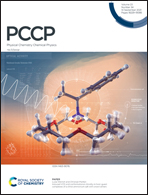A Dirac nodal surface semi-metallic carbon-based structure as a universal anode material for metal-ion batteries with high performance†
Abstract
The rapid development of electronic devices requires high power storage batteries. However, reported 3D carbon-based materials are semiconductors or metals and are used in Li- or Na-ion batteries with low capacities. Thus, it is of interest to discover whether there is a universal semi-metallic material for use in high performance Li-, Na-, and K-ion batteries. Inspired by the recent synthesis of 3D carbon-based materials, in the research reported here, a 3D regular porous structure (bct-C56) is designed using graphene sheets. The porous carbon-based material has mechanical, dynamic, thermal, and mechanical stabilities. Interestingly, bct-C56 exhibits semi-metallic features with two Dirac nodal surfaces with mirror symmetry, as well as high Fermi velocities, indicating high electron-transport abilities. More excitingly, its theoretical capacities are 743.8, 478.2, and 425.0 mA h g−1, with diffusion barriers of 0.05–0.12, 0.07–0.12, and 0.03–0.05 eV, average OCVs of 0.31, 0.45, and 0.59 V, and volume expansion levels of 1.2%, 0.02%, and 3.1%, in Li-, Na-, and K-ion batteries, respectively. All these excellent characteristics suggest that semi-metallic bct-C56 is a universal anode material for use in metal-ion batteries with a fast charge–discharge rate. In this research, not only was a new material with a Dirac nodal surface feature designed, but it also offers an approach for the creation of high performance and universal metal-ion battery anodes with 3D porous carbon materials.



 Please wait while we load your content...
Please wait while we load your content...